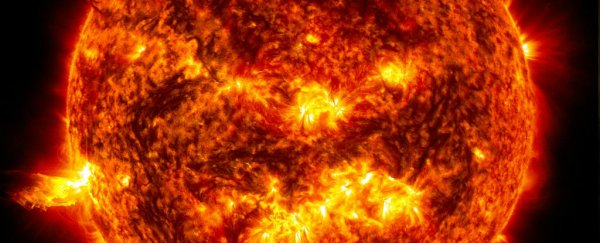Scientists have proposed a laser model that can could heat materials to temperatures hotter than the centre of the Sun in just 20 quadrillionths of a second. That's 10 million degrees Celsius almost instantaneously.
The discovery brings us one step closer to the dream of achieving thermonuclear fusion energy - the production of clean, sustainable, and limitless energy using the same process the Sun uses to produce heat.
The challenge in harnessing the energy from thermonuclear fusion is that, as with any form of energy production, you need to get out more than you put in, and heating things to temperatures that rival the centre of the Sun is not easy. Current laser technology has failed to make the heating process efficient enough to make the process worthwhile, but a team from Imperial College London in the UK has come up with a model for a laser than can heat things about 100 times faster than the world's most powerful fusion experiments.
While purely theoretical at this stage, the research gives offers up a completely new approach to the process of heating. Current fusion experiments use lasers to transfer heat energy to the electrons in a material, which in turn heats up the ions - particles that make up the bulk of physical matter - to achieve incredibly high temperatures.
The new process cuts out one of these steps by harnessing the electrostatic shockwaves produced by a laser beam to heat up the ions directly. "It's a completely unexpected result. One of the problems with fusion research has been getting the energy from the laser in the right place at the right time. This method puts energy straight into the ions," said one of the team, physicist Arthur Turrell.
The key to the discovery is figuring out the type of material that would allow for such efficient heating. In previous experiments, laser-induced electrostatic shockwaves have done little more than push ions ahead of them, accelerating the speed at which they travel in a material, but not heating them up.
Experimenting with various computer models, Turrell and his colleagues figured out that if you use a material made up of specific combinations of ions, they can be accelerated by the laser shockwaves at different speeds, which causes heat-inducing friction.
The effect appeared to be strongest in solid materials such as plastic that contain two types of ions. The process causes the ions to be squeezed together to almost 10 times the usual density of the material, and the combination of shockwaves, ion collisions, and increased density results in the production of lot of heat, fast.
"The two types of ions act like matches and a box; you need both," study co-author Mark Sherlock explained. "A bunch of matches will never light on their own - you need the friction caused by striking them against the box."
The next step will be for scientists to actually build the proposed experiment and achieve the same rate of heating for real. While faster rates of heating are already being achieved by particle accelerators like the Large Hadron Collider, this new laser experiment would allow for super-fast heating to be achieved far more easily, and with a whole lot less resources. And then the race will be on for researchers to use that to achieve efficient energy production.
"[T]he proposed technique could be explored at many laser facilities around the world, and would heat material at solid density," said Turrell.
The results have been published inNature Communications.
